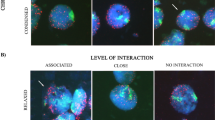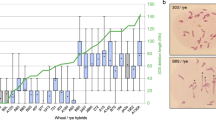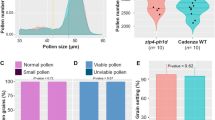Abstract
In the hexaploid bread wheat (Triticum aestivum 2n = 6x = 42) meiotic pairing is confined to fully homologous chromosome partners and inheritance is disomic. This arises from the activity of a single locus (Ph, pairing homoeologous) distally located on the long arm of chromosome 5B1,2. In the absence of chromosome 5B, pairing and recombination take place between homoeologous chromosomes, which are genetically related members of the three component genomes, as well as between homologues3. Knowledge of the 5B system is of fundamental and practical significance. It throws light on the process of chromosome pairing during meiosis4, and assists in the interpretation of the cytogenetic behaviour of polyploid wheat, and indeed of all allopolyploids. Moreover, interference with its activity has been exploited to cause abnormal recombination between homoeologues in order to introduce into wheat chromosomes useful genes from chromosomes of related species5. Consequently to extend the understanding of the system, as well as to facilitate its use in breeding work, attempts are continually being made to isolate new wheat genotypes displaying homoeologous pairing.
This is a preview of subscription content, access via your institution
Access options
Subscribe to this journal
Receive 51 print issues and online access
$199.00 per year
only $3.90 per issue
Buy this article
- Purchase on SpringerLink
- Instant access to full article PDF
Prices may be subject to local taxes which are calculated during checkout
Similar content being viewed by others
References
Riley, R., Proc. Third Intern. Wheat Genet. Symp., 185 (1968).
Wall, A. M., thesis, Univ. Cambridge (1969).
Riley, R., and Chapman, V., Nature, 182, 713 (1958); Riley, R., and Kempanna, C., Heredity, 18, 287 (1963).
Feldman, M., Proc. US Nat. Acad. Sci., 55, 1447 (1966).
Riley, R., Chapman, V., and Johnson, R., Genet. Res., Camb., 12, 199 (1968).
Sears, E. R., Proc. Third Intern. Wheat Genet. Symp., 53 (1968).
Riley, R., and Law, C. N., Adv. Genet., 13, 57 (1965).
Kimber, G., Genet. Res., Camb., 9, 111 (1967).
Riley, R., Heredity, 15, 407 (1960).
Riley, R., and Chapman, V., Heredity, 18, 473 (1963).
Author information
Authors and Affiliations
Rights and permissions
About this article
Cite this article
CHAPMAN, V., RILEY, R. Homoeologous Meiotic Chromosome Pairing in Triticum aestivum in which Chromosome 5B is replaced by an Alien Homoeologue. Nature 226, 376–377 (1970). https://doi.org/10.1038/226376a0
Received:
Issue date:
DOI: https://doi.org/10.1038/226376a0
This article is cited by
-
Dual effect of the wheat Ph1 locus on chromosome synapsis and crossover
Chromosoma (2017)
-
Production and characterization of arboreous and fertile Solanum melongena + Solanum marginatum somatic hybrid plants
Planta (2007)
-
Molecular characterization of Ph1 as a major chromosome pairing locus in polyploid wheat
Nature (2006)
-
Standard karyotype of Triticum umbellulatum and the characterization of derived chromosome addition and translocation lines in common wheat
Theoretical and Applied Genetics (1995)
-
Genetic control of a novel series of trypsin inhibitors in wheat and its relatives
Biochemical Genetics (1987)



